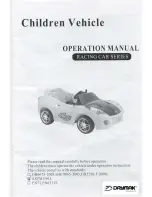
GRAUPNER GmbH & Co. KG D-73230 KIRCHHEIM/TECK GERMANY
Änderungen vorbehalten! Keine Haftung für Druckfehler 05/2009
54
Connect the clevises on the rudder and elevator pushrods to the servo output arms.
Make any adjustments required, then tighten the locknuts against the clevises and
apply a drop of UHU schraubensicher to prevent them working loose.
The rudder and elevator linkages must be set up carefully in such a way that the
control surfaces are at centre when the corresponding servos are at neutral. It is
essential to secure the clevises and locknuts using UHU schraubensicher.
Installing the electric motor and noseleg unit
Screw the noseleg to the nose bulkhead as shown in the photograph, then secure
the wheel on its axle using two collets. For the electric-powered version of the model
the speed controller should also be mounted on the nose bulkhead, as shown in the
photo.
Glue the plastic guide for the nosewheel steering pushrod to the nose bulkhead and
the former in front of the wing leading edge.
Connect the pre-formed end of the nosewheel steering pushrod to the steering arm,
and slip the rod through the guide tube and the cross-hole in the swivel pushrod
connector mounted on the servo output arm. With the servo at centre and the
nosewheel at the ‘straight ahead’ position, tighten the grubscrew in the swivel
pushrod connector to clamp the linkage.
Note that the swivel pushrod connector must be mounted on the servo output arm in
such a way that it rotates smoothly, but without significant lost motion.
Mount the electric motor on the nose bulkhead as seen in the photo.
Connect the motor to the speed controller, and check that the shaft spins in the
correct direction. Carry out this test
without
the propeller fitted.
The next stage is to fit the cowl, and this necessitates the removal of the noseleg
again. Fit the cowl over the nose of the fuselage and position it so that there is an
even gap about 1.5 mm wide between the front ring and the spinner backplate. The
cowl should line up with the top edge of the spinner backplate.
Mark the trailing edge of the cowl on the fuselage using a pencil or pieces of tape.
Measure the distance from the trailing edge of the cowl to the centre of the nose
bulkhead. Fit the cowl on the model again, position it accurately, and mark the hole
positions on the cowl for the retaining screws.
Note that these holes must be drilled accurately, as the screws have to engage in the
thickness of the nose bulkhead. Use two retaining screws on either side.
Mark the position of the hole in the underside of the cowl to clear the noseleg unit,
and drill a hole in the moulding about 2 mm greater in diameter than the noseleg.
Place the cowl on the model and fit the retaining screws. Insert the noseleg from the
underside and check that it runs through both brackets and the steering lever. Set the
nosewheel to the correct height, then tighten the cheesehead screw in the steering
lever to clamp it in place.




































